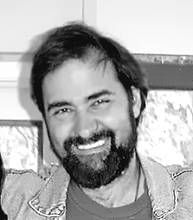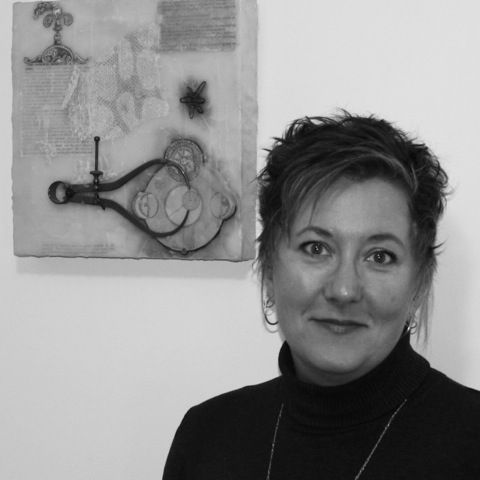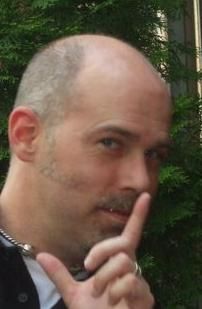 Andy Biggers
Andy BiggersAndy has been deeply involved in the North American Pagan and heathen community for over twenty five years. He is a past member of the board of directors of both Wic-Can Fest and Harvestfest – as well as serving on the board of directors of the American Vinland Association. He is an Elder in the Ásatrú faith and a past High Redesman of the Ring of Troth. Andy is also a key organizer and board member of SiMuCoR (Simcoe Muskoka Coalition of Old Religions), and holds several advanced academic degrees including Bachelor and Master’s degrees in History.
Mosaic Lecture - The Technology of Time Keeping in the Ancient North
We raise our eyes to the heavens. The celestial canvas unfolds like clockwork, revealing hints of the divine order of Creation. In this workshop, I will discuss the night sky, seasonal calendars, and time keeping from the ancient Northern European perspective. We will investigate how our ancestors marked the passage of the day tides, recognized the beginning of important agricultural feasts (planting and harvesting etc.), and regulated the passage of time in their world. More concretely though, the materials presented in this lecture will allow you construct a basic version of the traditional “Rune Clog” calendar – a device with which you will be able to calculate the date of every full moon, new moon, lunar eclipse, seasonal blessing, and day name for a period of one Aun (300 years).
Michel and Pamela Daw
Michel & Pamela are modern Stoics, reviving the ancient philosophical and spiritual path. Michel is a founding member of the College of Stoic Philosophers, an online study program for Stoic Practice. Pamela runs Stoici Civitas, a nacent umbrella organization for Stoic Spirituality. They have been jointly hosting monthly Stoic Workshops in the National Capital Region, the monthly Ottawa Region Pagan Discussion Night, and have spoken at festivals and conferences on Stoic Spirituality. Together, they also manage TheStoicLife.org, a Stoic website and resource center, as well as Words of the Ancient Wise, a daily Stoic blog.
Mosaic Lecture - The Path of the Stoics or How to Live the Good Life
This session will explore the re-emergence of Stoicism as a spiritual and philosophical path within the larger Pagan Mosaic. We will discuss the foundational principles of Stoicism and the Community which is being formed around them. The integration of Stoic philosophy with other Pagan paths will also be addressed. Come and see what the practise of Stoicism can add to your personal spiritual quest. What is Stoicism? - Stoicism is the study and practice of living a complete life based on reason and relationship, one where we explore and express our best selves, where we flourish to the best of our abilities in all places and circumstances. Stoics reach for personal excellence, which we call virtue, in all the domains of our lives, privately and publicly, to benefit ourselves and our communities. How is Stoicism a Spiritual Path? - Stoicism is the practice of changing the way we look at life to arrive at a point where our baseless worries are defeated, our paralysing fears abolished, our violent passions tempered, and our childish selfishness turned to generosity and compassion. Practising Stoicism involves all aspects of our being - body, mind and soul. We celebrate and honour our connections to Gaia and to each other. In short, it is to live deeply, purposefully and wholly. This is the Art of Living in accordance with Nature. Who is the Stoic Community? - We are a loosely connected group of men and women who have chosen to adopt Stoicism as an Art of Living. Our Stoicism is the same as the philosophy founded over two thousand years ago in Greece, and at the same time profoundly different, evolved for our current age and our current understanding of Science, Psychology, Philosophy and Religion. We choose to study and practice a philosophical life, in order to express our truest natures.
Tamara James
Tamarra was initiated as a witch on her 16th birthday, almost 45 years ago, and remembers that the big mystery she received was that there IS a Goddess. She was part of the hippy movement of the late '60s, and found flashes of the old religion at love-ins and anti-war activities. Away from her original coven, she kept her craft as a solitary, and still emphasizes solitary growth with her students. When work took her to the USA, she found the craft manifested in Pagan bookstores, some with publicly available Circles. Her knowledge of herbs and divination learned as a farm girl and counter-culture worker led the founders of the Blue Star tradition to adopt her as elder. Back in Canada, Tamarra opened The Occult Shop, and began to teach. Her students demanded a Church, with weekly meetings, and were numerous enough to require group classes. So she found herself at the head of Canada's only Pagan Church, complete with a religious education program. In Tamarra's experience with Pagan Women's groups, they were often short-lived due to politics, so when she formed Sistrum, politics were banned. Sistrum is now 30 years old. As High Priestess of the WCC, Tamarra was drawn into being the first Pagan clergy person to serve in a jail. One of her students created Canada's first Pagan festival. This continuing service to a public ministry made it obvious that she wasn't following the old rules about secrecy, and the things that work for a private coven don't work as well for a public Church. Tamarra had invented a new Tradition, which has become known as Odyssean. Tamarra has been either actively involved or very close on the sidelines for most of the growth of Paganism in Canada since it poked its nose out of the broom closet.
Mosaic Lecture - How We Got Here
Tamarra will be sharing through stories and personal experience the history of the Canadian Scene over years, how it has grown and changed. She will describe the transition from secrecy (some of it rather ridiculous) through the time of local community building, to our times of being on the edge of mainstream acceptance. It has been a peculiar route, and Tamarra has been in a position to observe much from various parts of Canada.
 Sydney Lancaster
Sydney LancasterSydney Lancaster is an Edmonton-based visual artist, writer, and musician. She creates mixed media assemblages, drawings, photographs, sculpture, and installations that examine the construction and interpretation of lived experience -- in particular, how we ‘map’ our sense of place and belonging (or lack thereof), in psychological and spiritual terms. Lancaster has exhibited in solo and group shows in Edmonton, Calgary, Toronto, Ottawa, and St. Albert, and curated CORTEX: a multidisciplinary event in 2006 and 2007 for the Edmonton Poetry Festival. Recent exhibitions and projects include: a collaborative multi-media exhibition and chapbook project entitled Archives of Absence (with poet Catherine Owen); Make: Believe - a site-specific sculptural installation; EGG - a sculpture-based ritual/performance; and new work for the group show Lost and Found, exhibited December 2011 - January 2012 at the Art Gallery of St. Albert. She is the Artist in Residence at Harcourt House artist-run centre in Edmonton for 2012. She is an OBOD Ovate, member of the Druid Network, was involved in organizing Gaia Gathering in Edmonton and Winnipeg, and has assisted in various capacities with the Spirit of the West Druid Gathering.
Mosaic Lecture - What the Land Told Me: Objects, Places, and Processes
What the artist did with what she found Western culture is heavily indebted to a long tradition of visual artists expressing their philosophical or spiritual views through their work, work which is for the most part, congruent with whatever dominant iconography and world view prevails at the moment of it its creation. In this context, the question arises: how does a 21st century, contemporary visual artist living and working outside the dominant cultural perspective, spiritual view, and prevailing visual language, create work that functions in a similar fashion? How can work be made that goes beyond simply presenting an alternative iconography, to speaking directly about the lived experience of that individual and make it relevant and understandable to people in the wider community? What does the ongoing process of integrating personal spiritual practice into lived action mean in relation to creative process and creative work? I invite you to join me in exploring these and related questions, through the lens of my work in mixed-media assemblage, installation, sculpture and drawing.
 Brian Walsh
Brian WalshBrian Walsh is a permanent part-time Spiritual Care Provider at a major Toronto hospital and a part-time Clinical Fellow in Spiritual Care at another major Toronto hospital. In the Canadian Association of Spiritual Care he is one of six members who identifies as part of a Pagan or Earth-based tradition. Additionally, Brian serves as Pagan (Celtic and Reconstructionist) chaplain at the University of Toronto, leads a private circle, and provides open rituals and presentations in the local community.
Brian is a priest in the Céilí Sídhe tradition of Celtic Paganism and holds a B.A. in Celtic Studies and Religious Studies from the University of Toronto, as well as an M.Phil. from the University of Wales. Also, as a licensed Wedding Officiate, Brian is able to perform legal weddings in the province of Ontario. Brian's passions include Celtic Studies, World Religions, Mythologies, Story-telling, Frame Drums, and Dogs.
Mosaic Lecture - Myth, Mystery, and Meaning: Different Understandings of the Divine; Why They Divide Us, and Why They Shouldn't
We all say that we value religious freedom, and we all say that in Paganism we are free to understand the world through the lenses that work best for us, and yet we aren't always just one big happy family. In this presentation, we will explore some the different ways deity and mythology have been understood in our community, as well as the value and limits of these understandings. Notions like hard and soft polytheism, transcendence and immanence, gender dualism, the role of a pantheon, and more will be explored as problems in our modern context, and solutions rooted on our ancient source cultures will be offered. Ancient Celtic, Greek and Vedic examples will be used to provide insight and poetic beauty that can lead us from being a fractured collection of random shards to being a community mosaic where different worldviews can be understood in the light of a deeper matrix or pattern than makes room for all. Whether you're a Recon, a Wiccan, or an academic; no one's assumptions will be complete safe in this 90 minute rollercoaster ride, but we will all come through unscathed, and closer as a community, so long as your arms and legs are kept inside the vehicle at all times.
 Witchdoctor Utu
Witchdoctor UtuWitchdoctor Utu is the founder of the Niagara Voodoo Shrine, the world renowned Pagan drum troupe the Dragon Ritual Drummers and is a member of the New Orleans Voodoo Spiritual Temple. He has been traveling the continent for over a decade sharing the traditions and mysteries of North American voodoo with lectures, workshops and rituals at some of the continents top tier spiritual festivals. Utu is a regular contributor to the international publication "Hoodoo and Conjure Quarterly Magazine". niagaravoodooshrine@hotmail.com
Mosaic Lecture - North American Voodoo; Separating fact and fiction, truth and misconception.
Voodoo has been gaining interest in the North American Pagan communities and festivals for a few years now, however it was not always the case. Not that long ago, Voodoo workings were frowned upon or outright banned from many events. It is still not a cozy relationship, even in the southern U.S. Canada, and in particular Ontario, has however been ahead of the bell curve in acceptance. Voodoo in its many forms is one that many Neo-Pagans simply do not understand; The complexities of its different traditions from Santeria, Ifa and Voodoo itself, to the lore of animal sacrifice and believed lack of any morals towards "karma" and magikal practices. All these will be discussed as well as a hands on example of a Voodoo working will be demonstrated as well as various tools and accouterments on display.




No comments:
Post a Comment